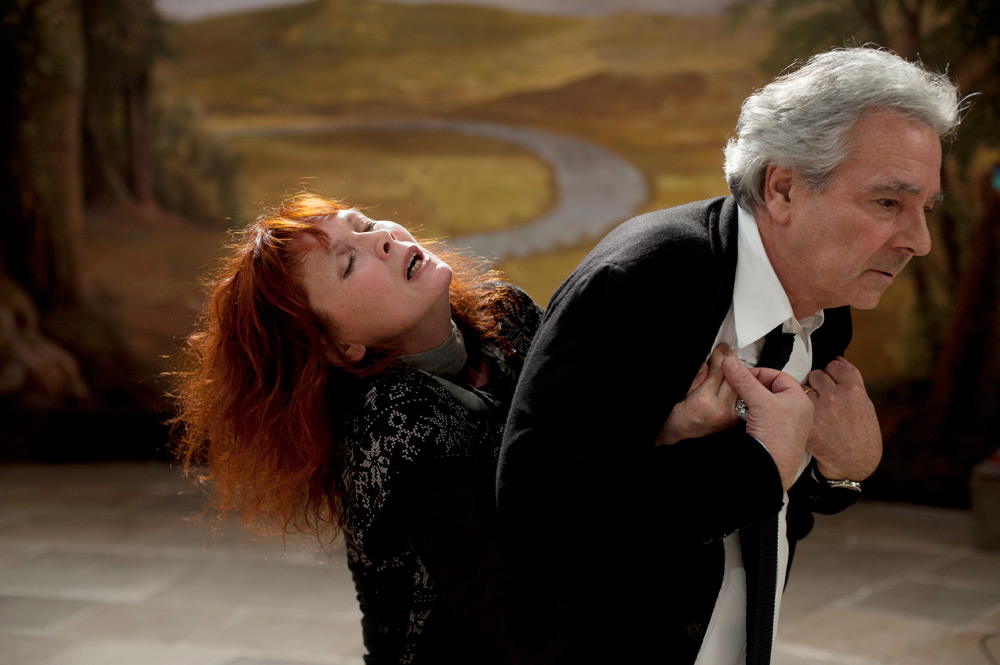By Armond White
The Cinemascope frame stretches just wide enough to contain Alain Resnais’s abundant ideas about memory, imagination, love, art, death and life in You Ain‘t Seen Nothin’ Yet. Taking full measure of that vaudeville phrase (also the title of Andrew Sarris’ essay collection containing his superb monograph on Joseph von Sternberg), Resnais fulfills its promise in a high art exercise sumptuous enough for Sternberg. Resnais not only pokes fun at high art pretenses, part of the point of You Ain‘t Seen Nothin’ Yet is to explore them: When the associates of a theater director/playwright are summoned to attend his memorial, they are treated to his video-taped will which includes a new video performance by a troupe of younger actors performing his play Eurydice.
 The mourners are an august bunch–eccentric, elegant artistes (Sabine Azema, Pierre Arditti, Anny Duperay, Lambert Wilson. Anne Consigny, Mathieu Almaric among them, all introduced in a clever credit/curtain call sequence). They’re already familiar with Eurydice, having performed it themselves over the years. But watching the video production sends each of them into personal reveries about the Orpheus myth and their own histories with each other and the commands of their god-like director/playwright. Resnais ingeniously captures the many layers of their memory, fantasy, desire and dread. Contrasting the richness of these intertwined personal projections and the spare video are just the beginning of Resnais’ caprice.
The mourners are an august bunch–eccentric, elegant artistes (Sabine Azema, Pierre Arditti, Anny Duperay, Lambert Wilson. Anne Consigny, Mathieu Almaric among them, all introduced in a clever credit/curtain call sequence). They’re already familiar with Eurydice, having performed it themselves over the years. But watching the video production sends each of them into personal reveries about the Orpheus myth and their own histories with each other and the commands of their god-like director/playwright. Resnais ingeniously captures the many layers of their memory, fantasy, desire and dread. Contrasting the richness of these intertwined personal projections and the spare video are just the beginning of Resnais’ caprice.
You Ain’t Seen Nothin’ Yet moves into greatness when the mourners become fully engaged, both speaking and acting-out their pasts. We see their immediate feelings, as when Azema and Arditti, unable to face each other, reenact Orpheus and Eurydice’s underworld embrace. Azema has become Resnais’ loony redhead muse and Arditti represents his soulfulness. It’s a highpoint; going to the core of their experience, the myth is made urgent and intense. The palatial estate setting gives way to dreamy, stage-like spaces, even split-screen montages, across the screen’s expanse and the narrative goes inward–deeper into their spiritual and romantic consciousness.
This stuff is certainly avant-garde (if that term can still be used for an artistic project that has always interested Resnais and already transformed cinema culture more than 50 years ago) but as the Orpheus reference suggests, it is also classical. The film’s basic strategies are fundamental to the way and the reason humans make art against time and how they respond to it. So it’s also show business which Jean Cocteau understood when he modernized myth in Orphee (1950). Resnais, as always, shows our cognitive processes only now, in his 90s, he’s sophisticated enough to play with his conceit’s cinematic theatricality.
That oxymoron is as fascinating as it is confounding. You Ain’t Seen Nothin’ Yet exposes how banal most other pop narratives lose the mythological significance that has sustained human culture. Resnais highlights that significance, using the wide screen as the mind’s playhouse. His always sumptuous visual style takes on new luster with Eric Gautier, the great cinematographer who lights with pastel softness yet also uses the drama of deep chiaroscuro. Gautier and Resnais take thinking (and looking) outside the box to breathtaking levels of perception–luxurious perception. Colleague Stuart Lee of WNYN Channel 39 gave a definitive response to You Ain’t Seen Nothin’ Yet: “It’s like a chinchilla coat–heavy to wear but beautiful.”
Resnais’s style used to be held against him but it’s part of what makes his cinematic project undeniable: His great themes Time and Thought receive their most esthetic treatment as in the graceful rhythms of Last Year at Marienbad, the speed of the edits in Muriel and the sheer gorgeousness of his recent renaissance (Private Fears in Public Places, Wild Grass and You Ain’t Seen Nothin’ Yet). His intellectual and esthetic inquiries can seem remote, yet they’re also lavish. This film contemplates experience and oblivion, the artistic mythologizing of life and death, the ineffable and the sublime.
If you can take the cast of mourners’ grief and passion as a surreal demonstration of art imitating life, Resnais meets both Luis Bunuel and Jacques Rivette at their own games. You Ain’t Seen Nothin’ Yet ends with a Frank Sinatra recording as if to demonstrate that the richest art should also be the most accessible. No less playful than Resnais’ other jests here, it’s perfectly elegant and profound.
Follow Armond White on Twitter at 3xchair
